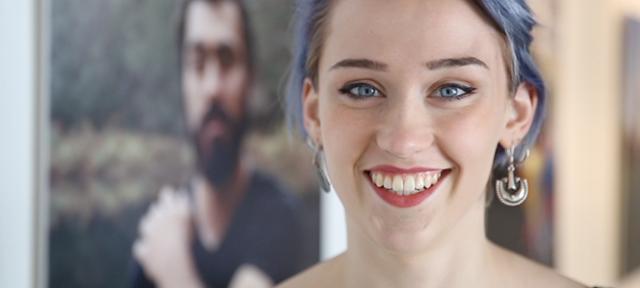Division III Profile: May Hemler's "Be My Body, Read My Books"

May Hemler’s Division III capstone project shatters preconceived notions about the disabled, and she accomplishes that partially through sheer size. The project, “Be My Body, Read My Books,” features ten 40" x 32" portraits of disabled individuals, shot on film and processed digitally.
“Large-format photography has the power to give subjects a heightened, more intense appearance — it really focuses on the detail, and you can create these larger-than-life portraits of your subjects,” she says. “I wanted all of the subjects to feel really powerful: that’s why I chose large format.”
The title of Hemler’s project comes from a song by the punk band Ian Dury & the Blockheads that bemoans the often pandering behavior by the general populace toward disabled people. “I tried to photograph my subjects in a way that turned the pitiful gaze that disabled people often get upside down,” she says. “I didn’t want viewers to pity my subjects at all — I wanted them to be taken aback by how whole and strong the people look.”
Hemler made use of online networks to find her subjects in the New England area, a task she says was challenging, as disabled people are often reclusive and even encouraged to hide their differences. “It’s hard to create community when people have difficulty leaving home,” she says.
Shooting with film, a process without the quicker perks of digital photography, gave Hemler extra time to establish a rapport with her subjects. “The process of setting up each image enables me to talk with my subject and help the person become comfortable on the other side of camera,” she says. “Working in this way forces me to slow down and make portraits that provide every subject with an opportunity to be seen in a way contrary to the way that disabled people usually are.” [See Hemler's portraits in the gallery below.]
In addition to the portraits, Hemler amassed a collection of what she refers to as “image- and object-based disability history.” Sourced from online collections, museums, and books, the historical images are portraits of disabled people at their place of work, in their home, in the studio, or with family and friends. Also included are posters, pamphlets, and postcards that Hemler says help to illustrate the often well-intentioned but ultimately damaging role that disability advocacy has played. She also incorporates images of protests and resistance to counter misconceptions.
Professors Billie Mandle (chair) and Michael Lesy served on Hemler’s Division III committee. “I really benefited from having strict advisers who were always supportive when I needed that,” she said. “They really knew me, and knew what I was going for. They helped me make work I was proud of.”
Mandle led Hemler to a volunteer teaching job at the CARE center, which provides services for teenage mothers in Holyoke. After starting as an assistant in the classroom, Hemler eventually took over as the lead teacher, designing and implementing lesson plans.
One of Hemler’s unique additions to the classes was the use of analog photography. “Hampshire has multiple darkrooms — it’s important that we share these resources. Otherwise students wouldn’t have opportunity to develop their own film,” she says. “I got to see the students be as mesmerized by the process as I was when I was introduced to it.”
Hemler also served as a teacher’s assistant in classes for Lesy and for Professors Claudio Nolasco and Amanda Herman. All these experiences inspired Hemler to pursue teaching art professionally, after she graduates this month.



